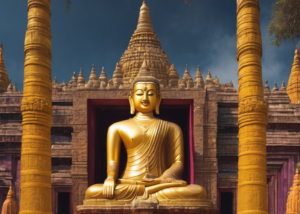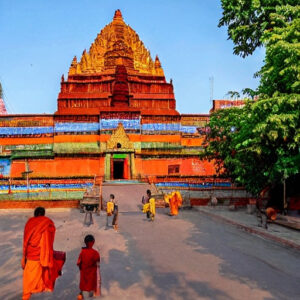Table of Contents
Best in Bodhgaya – A Famous Place to Visit 2024
Best in Bodhgaya offers numerous tourist attractions that can be explored all year-round; however, October to March are ideal months for visiting this picturesque location.
Uruvela village hosts this stupa in memory of where Buddha meditated and attained enlightenment, making this an incredibly significant site for Buddhists, with visitors flocking there regularly to witness it. Best in Bodhgaya

Best in Bodhgaya Muchalinda Lake
Muchalinda Lake is a tranquil and picturesque place that attracts visitors and devotees from across the world. It hosts various festivals and events all year long that bring crowds of tourists. Furthermore, Muchalinda Lake boasts an abundant bird population which visitors can take up bird watching as a hobby here.
This site is well known for its mythological significance and provides travellers with a tranquil spot. Legend has it that Lord Buddha was meditating at this spot during the sixth week of his enlightenment under a Bodhi tree when a storm broke out; Shesh Naga or Snake King Muchalinda emerged from the water to protect him, even using his hood as protection. A structure depicting this epic tale now stands in the center of Lake Como.
Tourists can admire this scenic locale any time of day, but for an enchanting experience visit after sunset to witness its magical grandeur. The lake will be beautifully illuminated and Lord Buddha on his serpent looks spellbinding – you won’t want to leave! Best in Bodhgaya
Best in Bodhgaya Multimedia Museum
The museum provides visitors with a visual glimpse into Lord Buddha’s life from childhood until attaining Nirvana and also includes content related to his teachings. It is divided into four sections.
Attractions at this museum include statues of Buddha, Maitreya, Manjusri, Avalokitesvara and Tara. There is also an ancient Buddhist quadriga relief depicting Surya riding between pillars.
As well as its exhibits, the museum provides guided tours in multiple languages that provide visitors with a deeper insight into Buddhism and the exhibits displayed.
Bodhgaya Multimedia Museum is a popular tourist attraction and popular with both locals and visitors. Situated near Mahabodhi Temple complex, this popular attraction is easily reached via bus or taxi and features a cafeteria serving both vegetarian and non-vegetarian fare from morning until evening; for optimal experience visit during daylight hours as the museum closes on Mondays and Fridays.
Best in Bodhgaya Ajapala Nigrodha Tree
The Ajapala Nigrodha Tree is one of seven sacred elements that comprise
Mahabodhi Complex, a UNESCO World Heritage Site. It is believed to be descended from the original Bodhi Tree where Siddhartha Gautama attained enlightenment and eventually became Buddha, and where his fifth week of meditation after attaining enlightenment ended with him holding a discourse on religion, humanity, and equality; also it’s where Mara attempted to tempt Buddha while Sujata offered him milk-rice meal from Sujata!
Pilgrims visit Ajapala Nigrodha, an Awyan tree, for walking meditation practice and learning about various aspects of Buddhism. It is said that wherever Buddha stepped while meditating under this tree, lotuses blossomed, so raised structures with symbols of flowers have been put up at this spot. Furthermore, during his fourth week post enlightenment it is said he meditated deeply upon Abhiyankara in Ratanaghara (Jewel House shrine) northwest of Bodhi Tree with six colored rays emanating from his body that later depicted on Buddhist flags today. Best in Bodhgaya
Best in Bodhgaya Dungeswari Caves
Dungeswari Caves are revered by Buddhist pilgrims and visitors looking for peace and spiritual enlightenment alike, often visiting to find solace at this spiritual pilgrimage site located northeast of Bodhgaya. Home to numerous ancient temples where visitors can meditate and reflect upon their spiritual journey.
The caves at Sanchi are named for a local king who once reigned here, and according to legend, Buddha meditated here for six years prior to traveling to Bodh Gaya for further spiritual enlightenment. Legend has it that during these six years of intense self-mortification – including near death itself – Buddha met Sujata from nearby village who offered food, leading him to realize neither indulgence nor self abasement were essential components for true enlightenment.
Caverns found beneath Gaya house both Hindu and Buddhist shrines, which are said to provide visitors with transcendental energy that benefits their well-being. Accessing Gaya is more convenient for getting to the caves than Bodh Gaya due to being less congested; travellers can easily take a rickshaw directly to the caves for an easy journey.
Best in Bodhgaya Great Buddha Statue
The Great Buddha Statue, also known as Phra Phuttha Rattana Mongkhon Mahamuni, is perhaps one of the most iconic Buddhist monuments. It depicts a reclining Buddha who rests his head upon either a pillow or propped up by hand and elbow. Many interpret this representation of Buddha as depicting his final moments before passing away and entering nirvana; such an experience called parinirvana can only be attained through attaining enlightenment (or Nirvana).
This bronze statue depicting a seated Buddha usually features his hands in Dhyani Mudra, or meditation gesture, which makes this type of Buddha suitable for those looking to cultivate inner stillness and tranquillity in their lives or are interested in honing their meditative abilities.
This statue of Jizo Bodhisattva symbolizes the Bodhisattva Vow – which seeks to release all beings from suffering both physically and spiritually – by providing comfort, protection, and support in all six realms of existence. She often depicts herself with children. This symbolism stands as an embodiment of compassion and protection for women, children, travelers, etc. Best in Bodhgaya
Best in Bodhgaya Royal Bhutan Monastery
Royal Bhutan Monastery stands out in Bodhgaya thanks to its stunning Bhutanese architecture and serene atmosphere, making it a must-visit attraction. Buddhist followers also flock here in order to learn about Buddha’s life and principles, making the monastery accessible year-round but ideal during cooler months from October March.
At the heart of Bhutan’s holy city lies an impressive monastery built by King Mengsu as a tribute to Buddha. This lovely monastery features intricate clay carvings depicting important episodes from his life which draw in millions of Buddhist followers worldwide. Additionally, this spiritual retreat boasts its own temple, rest house, and accommodation facilities so travellers seeking an immersive spiritual experience can stay within its grounds.
At this location, it holds great spiritual significance; Buddha achieved Nirvana after years of meditation under the Bodhi Tree and this location bears that witness to this profound event. Visitors to this serene area can explore this monastery’s rich history and culture while taking leisurely strolls in its beautiful grounds.
Best in Bodhgaya Chinese Temple
Chinese temples boast their own distinctive style that differs significantly from that of Buddhist ones. Typically they feature large halls and shrines on an east-west axis with tile roof buildings decorated with religious figures or symbols to bring luck.
Temples typically feature a Hall of Heavenly Kings to either side of their main entrance, dedicated to four heavenly kings that defend Dharma and live in Caturmaharajika heaven.
Chinese temples feature another distinctive element – pagodas – similar to Indian stupas that serve to store sacred objects like books of prayers or relics.
While visiting a Chinese temple, another activity you may wish to participate in is making donations. Donations should be presented either near the entrance or where incense is distributed by staff members – though these contributions are usually voluntary, many make them hoping that doing so will bring good luck!
Best in Tibetan Refugee Market
Bodhgaya’s Tibetan Refugee Market is one of the top spots to visit. Offering souvenirs and woollen clothing suitable for winter wear, as well as traditional Tibetan caps, sweaters and jackets with Jana Kchari designs, it is known for being an exciting shopping experience.
This market was originally established by Tibetan refugees living in the area. Today, it serves as an iconic tourist destination, selling an array of woollens, books and cultural artifacts along with junk jewelry like figurines of Hindu deities or animals as well as Buddhist-related trinkets.
Royal Bhutan Monastery stands out as one of Bodh Gaya’s must-see sites, featuring
intricate 3-dimensional clay carvings that illustrate scenes from Gautam Buddha’s life and architecture that is sure to mesmerize visitors. Additionally, its serene ambience provides visitors with the ideal place to sit down and meditate before returning home for some peaceful reflection. Furthermore, this monastery features lovely gardens as well as an iconic bronze statue depicting Buddha.


